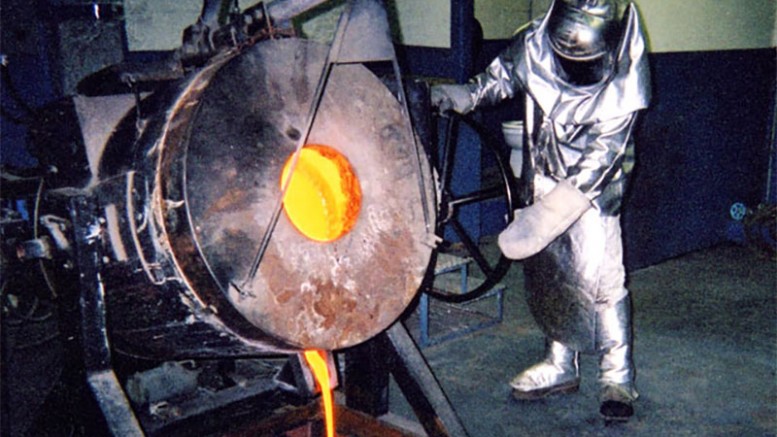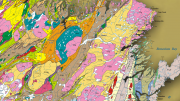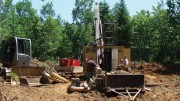Maritime Resources (TSXV: MAE) has gotten inventive with its financings to help advance its 100%-held Green Bay gold property in Newfoundland and Labrador. The junior has offered a streaming royalty as part of its equity raises, where investors will receive their investment back once production starts.
“We came up with the idea, let’s say mid-2015, as an incentive to our shareholders that are participating in the funding that is going to get us up and going. It was tough to raise money. So it was a creative way to incentivize the new coming shareholders to invest in the company,” Maritime’s president and CEO Douglas Fulcher says.
Maritime first implemented the idea in a non-brokered private placement last November. It closed part of that financing this February, and offered the royalty again in a financing in April. In total, it raised $985,500 in those two equity raises.
While investor sentiment has improved with the higher commodity prices this year, Maritime has continued to sweeten its financings.

On an outcropping vein near the historic Hammerdown project at Maritime Resources’ Green Bay gold property in Newfoundland, from left: COO Andrew Pooler, vice-president of exploration Bernie Kahlert and project manager Kevin Milledge. Credit: Maritime Resources.
On July 20, the Vancouver-based junior closed a $2.5-million, non-brokered private placement, where it issued 16.5 million equity units at 14¢ per unit and 16.5 million royalty units at 1¢ per unit.
Each investor will receive one share and a half warrant under the equity unit, where each full warrant would help the holder buy one share at 20¢ for 36 months. Each investor will also get a transferable royalty deed, where Maritime would return 100% of their investment once commercial production starts in either cash or gold, at the company’s option.
“It’s a creative way to create a bonus for the shareholders. The real idea behind it is they get paid out of production,” Fulcher says. “It’s not an ongoing royalty. It’s a royalty that’s based on their investment, and it comes out of 10% of net cash flow.”
Maritime will make the royalty payments annually, starting on the first anniversary of when commercial production begins. It will terminate the royalty payments once it repays 100% of the total offering, plus the sum of its previous two financings.
The funds will help bring the past-producing underground gold mine on the Green Bay property back into production.
The 51.7 sq. km property consists of the former Hammerdown mine, including the Rumbullion and Muddy Shag zones in the north. It contains the Orion gold deposit, located 1.5 km south, and the Lochinvar base-precious metals deposit, located 1 km east of Hammerdown.
The property is 14 km northwest from Springdale, the economic and business centre of the Green Bay area, and has direct access to Highway 391 via a 4 km logging road.
Richmont Mines (TSX: RIC; NYSE-MKT: RIC) operated the Hammerdown mine between 2000 and 2004. It recovered 143,000 oz. gold from 291,400 tonnes grading 15.83 grams gold per tonne. It processed the Hammerdown ore at the Nugget Pond mill, now owned by Rambler Metals & Mining (TSXV: RAB). Gold recoveries averaged 97%. However, due to the low gold prices, averaging US$325 per oz., Richmont shuttered the operation.
Previous owner Commander Resources (TSXV: CMD) resumed responsibility of the Green Bay property in 2005 and continued exploration work.
By 2010, Maritime, then BMB Capital Corp., a capital pool company, agreed to acquire the property. Through the acquisition, Commander received 17 million shares, of which it currently holds 8.4 million. Maritime has an option to buy most of those shares back over the next year, Fulcher notes. Commander also holds a 2% net smelter return royalty, and Maritime could buy back half for $1 million until commercial production starts.
Since acquiring the property, Maritime has focused its exploration on the Hammerdown deposit, which contains a series of stacked gold vein zones. There are nine gold-bearing veins with enough grade and continuity to be included in a reserve estimate.
In May 2013, Maritime published resource estimates for the Hammerdown and Orion gold deposits. Using a 3 gram gold cut-off grade, Hammerdown hosts 271,000 oz. in measured and indicated (727,500 tonnes at 11.59 grams gold), plus 436,000 oz. in inferred (1.8 million tonnes at 7.68 grams).
The lower grade Orion deposit has 157,000 oz. in measured and indicated (1.1 million tonnes at 4.47 grams gold), plus 225,100 oz. in inferred (1.3 million tonnes at 5.44 grams), at the same cut-off grade.
To outline the mining potential at Hammerdown, the junior recently hired engineering firm WSP Canada to complete a prefeasibility study (PFS). Hammerdown contains underground workings, as opposed to Orion, making it cost-efficient to mine.
The underground workings “are fairly simple to access in that we just take a plug out, open the portal, get a permit to dewater, and we would have access to that (4-by-4-metre) decline that goes to the bottom of the workings,” Fulcher reveals.
That said, he adds Maritime might take a bulk sample at Orion from surface as additional mill feed.
It aims to publish the PFS in the fourth quarter. “I’m going to say with luck and a big stick, maybe we can get it out in October,” Fulcher estimates.
Meanwhile, Maritime intends to permit Hammerdown as an under-600-tonne-a-day operation, under the province’s small-scale operations regulation.
It is applying for a dewatering permit as well as completing an environmental assessment application. Fulcher expects to complete the application this year, noting the company wouldn’t dewater until first-half 2017.
While Maritime doesn’t know what it would cost to get Hammerdown back into production until the PFS is out, Fulcher says the company’s in-house model has pegged the cost between $30 million and $40 million. “We are very conservative on that estimate, but that’s why we are doing a PFS. It has to be ground truth through the PFS.”
The executive estimates most of the start-up capital will go towards building the facilities and buying the underground mining equipment, if Maritime chooses to self-mine the deposit.
Once in production, Maritime intends to truck the ore to Rambler’s Nugget Pond mill, about 140 km away. In May, it signed an engineering, evaluation and service agreement with Rambler, where the companies will negotiate management services and toll milling fees.
“It’s a win-win for both companies,” Fulcher says. “Rambler has a gold circuit at the mill sitting there idle. For us, it saves us capital costs for a mill and permitting time, as we don’t need to put a tailings pond on site.”
Meanwhile, the junior intends to initiate a 3,000-metre drill program this year to upgrade part of the inferred resource into measured and indicated, as well as to test the extensions on the Rumbullion zone to the northeast, after more geophysics.
“We have low-hanging fruit,” Fulcher notes. “It wouldn’t take a lot to move some of that inferred into the measured and indicated category.”
Asked when Hammerdown may reopen, Fulcher says that “if all my Christmases came on the same day, I’d say two years. But you never know what is going to come out when you are going through the permitting process.”
That said, he maintains the permitting should be straightforward, as there was historically no acid drainage on the waste rock. Based on the company’s testing on the water in the decline, there were no “real nasties,” such as arsenic, mercury and antimony.
“The whole idea is to build this. We have been through some tough times in the market,” Fulcher adds.
Given the uptick in gold prices, where the spot price in Canadian dollars traded above $1,750 per oz., “it’s rewarding to have a Canadian gold project right now,” Fulcher says. “You are going to see a lot more people looking out for Canadian gold projects. It sort of seems to be the flavour right now.”
Maritime shares recently closed at 25¢, within a 52-week range of 8¢ to 31¢.





Be the first to comment on "Maritime offers streaming royalty to investors"